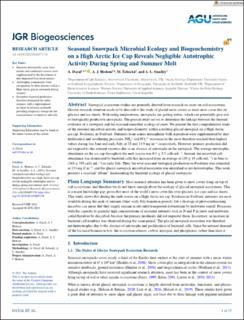| dc.contributor.author | Dayal, Archana | |
| dc.contributor.author | Hodson, Andrew | |
| dc.contributor.author | Šabacká, M. | |
| dc.contributor.author | Smalley, A.L. | |
| dc.date.accessioned | 2023-11-17T08:33:41Z | |
| dc.date.available | 2023-11-17T08:33:41Z | |
| dc.date.created | 2023-10-17T14:38:02Z | |
| dc.date.issued | 2023 | |
| dc.identifier.citation | Journal of Geophysical Research (JGR): Biogeosciences. 2023, 128 (10), . | en_US |
| dc.identifier.issn | 2169-8953 | |
| dc.identifier.uri | https://hdl.handle.net/11250/3103112 | |
| dc.description.abstract | Snowpack ecosystem studies are primarily derived from research on snow-on-soil ecosystems. Greater research attention needs to be directed to the study of glacial snow covers as most snow cover lies on glaciers and ice sheets. With rising temperatures, snowpacks are getting wetter, which can potentially give rise to biologically productive snowpacks. The present study set out to determine the linkage between the thermal evolution of a snowpack and the seasonal microbial ecology of snow. We present the first comprehensive study of the seasonal microbial activity and biogeochemistry within a melting glacial snowpack on a High Arctic ice cap, Foxfonna, in Svalbard. Nutrients from winter atmospheric bulk deposition were supplemented by dust fertilization and weathering processes. NH4+ and PO43− resources in the snow therefore reached their highest values during late June and early July, at 22 and 13.9 mg m−2, respectively. However, primary production did not respond to this nutrient resource due to an absence of autotrophs in the snowpack. The average autotrophic abundance on the ice cap throughout the melt season was 0.5 ± 2.7 cells mL−1. Instead, the microbial cell abundance was dominated by bacterial cells that increased from an average of (39 ± 19 cells mL−1) in June to (363 ± 595 cells mL−1) in early July. Thus, the total seasonal biological production on Foxfonna was estimated at 153 mg C m−2, and the glacial snowpack microbial ecosystem was identified as net-heterotrophic. This work presents a seasonal “album” documenting the bacterial ecology of glacial snowpacks. | en_US |
| dc.language.iso | eng | en_US |
| dc.publisher | American Geophysical Union | en_US |
| dc.rights | Navngivelse 4.0 Internasjonal | * |
| dc.rights.uri | http://creativecommons.org/licenses/by/4.0/deed.no | * |
| dc.title | Seasonal Snowpack Microbial Ecology and Biogeochemistry on a High Arctic Ice Cap Reveals Negligible Autotrophic Activity During Spring and Summer Melt | en_US |
| dc.type | Peer reviewed | en_US |
| dc.type | Journal article | en_US |
| dc.description.version | publishedVersion | en_US |
| dc.rights.holder | © 2023. The Authors | en_US |
| dc.source.pagenumber | 15 | en_US |
| dc.source.volume | 128 | en_US |
| dc.source.journal | Journal of Geophysical Research (JGR): Biogeosciences | en_US |
| dc.source.issue | 10 | en_US |
| dc.identifier.doi | 10.1029/2022JG007176 | |
| dc.identifier.cristin | 2185613 | |
| dc.relation.project | Norges forskningsråd: 288402 | en_US |
| cristin.ispublished | true | |
| cristin.fulltext | original | |
| cristin.qualitycode | 2 | |

